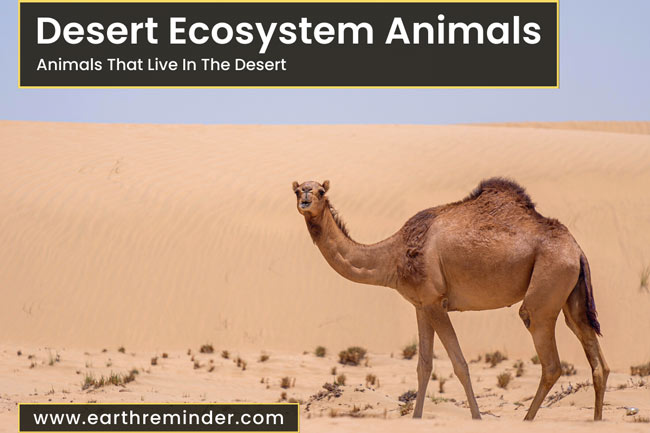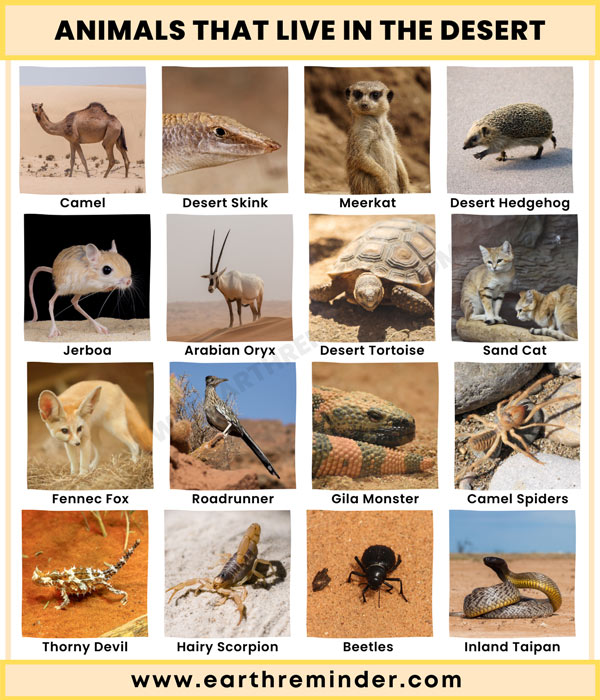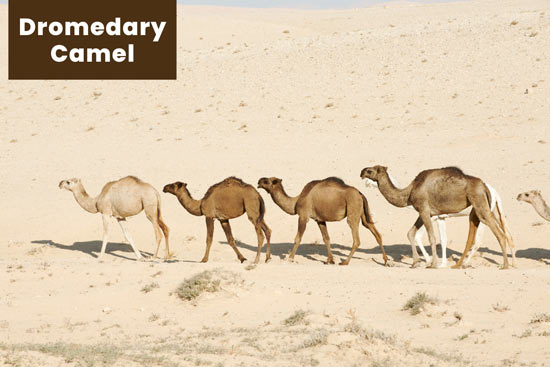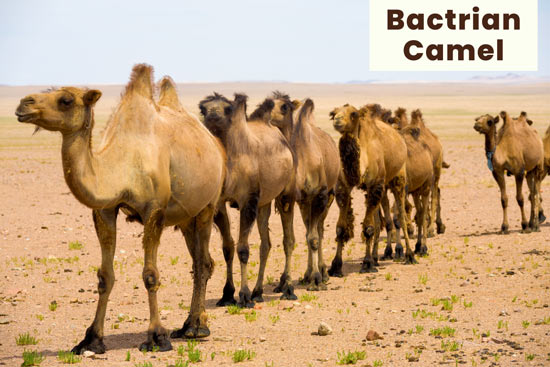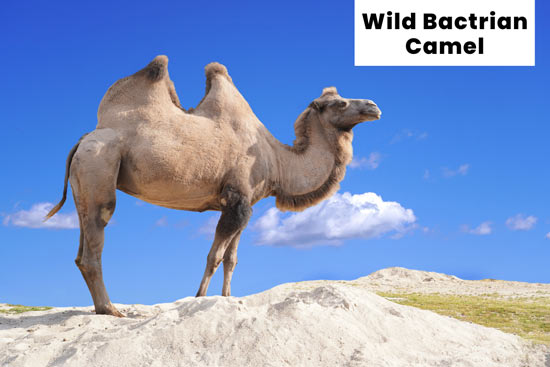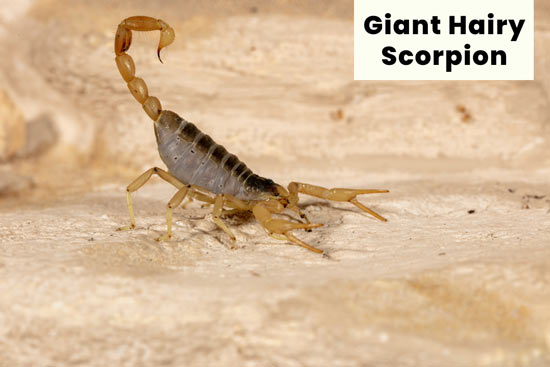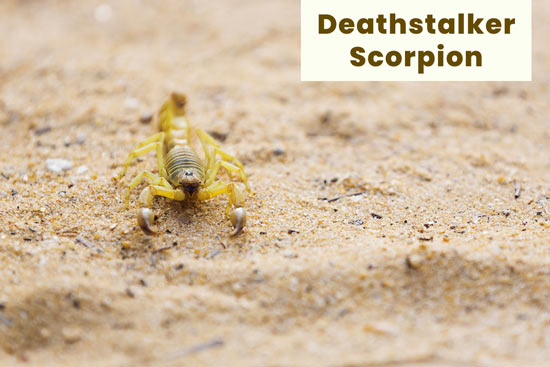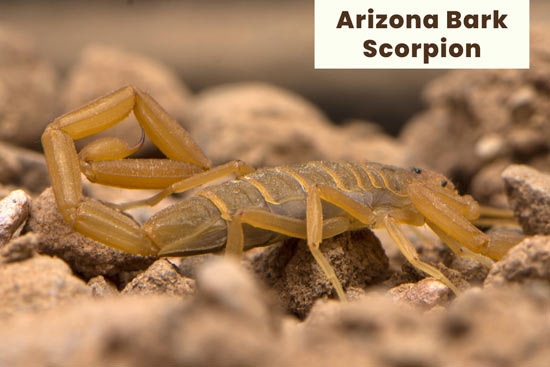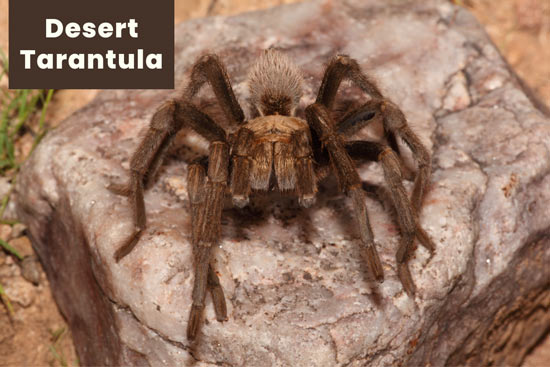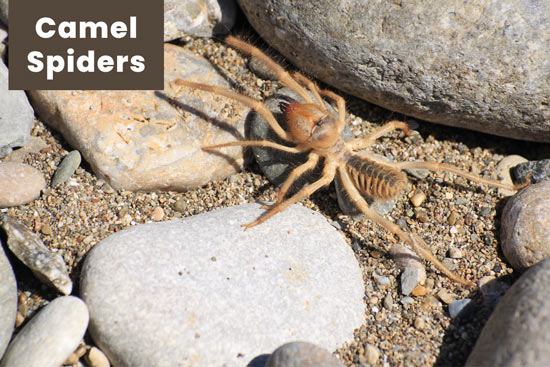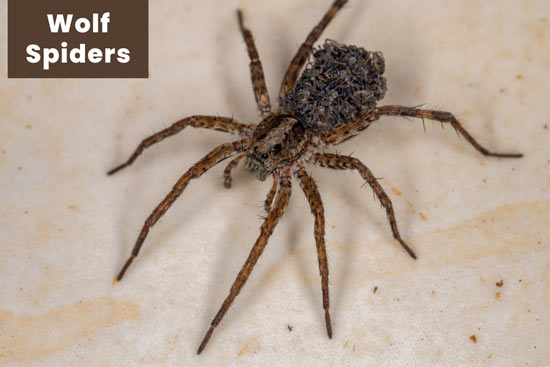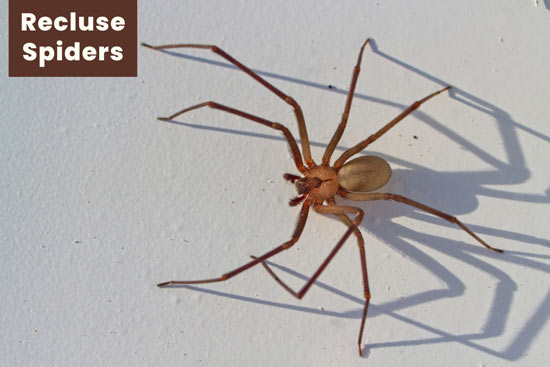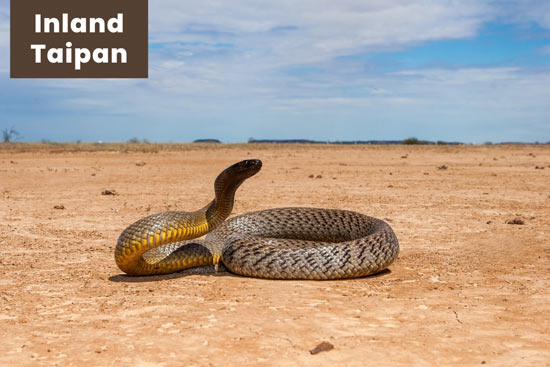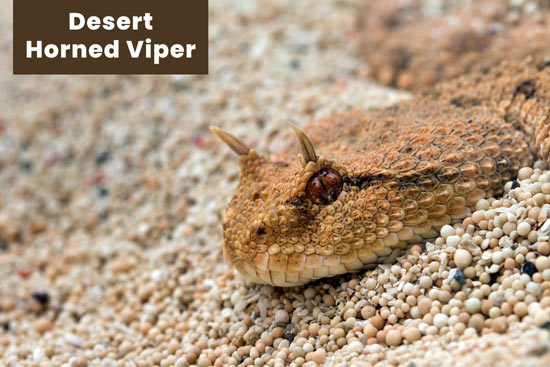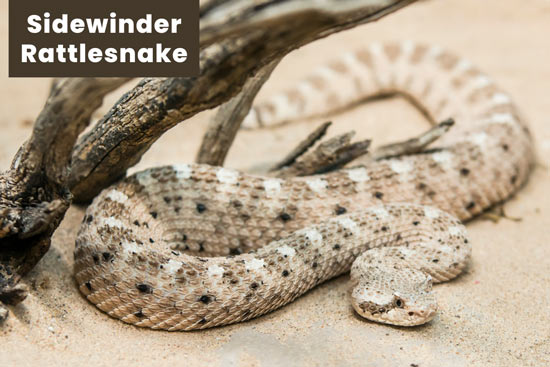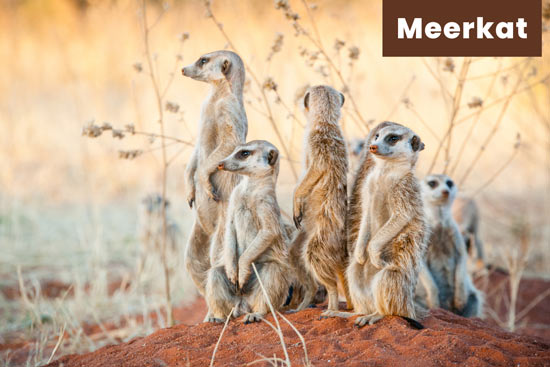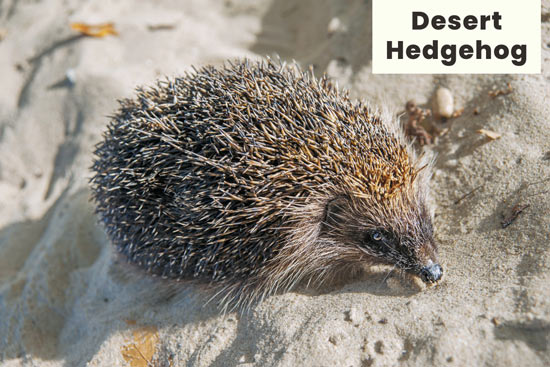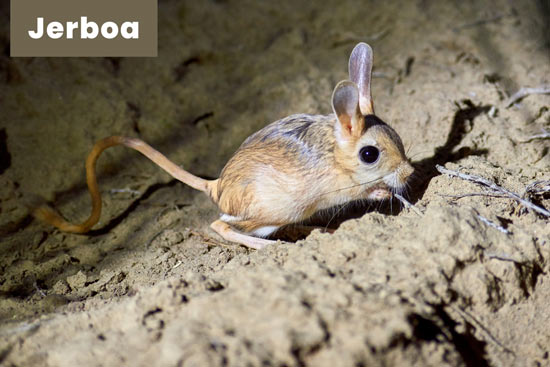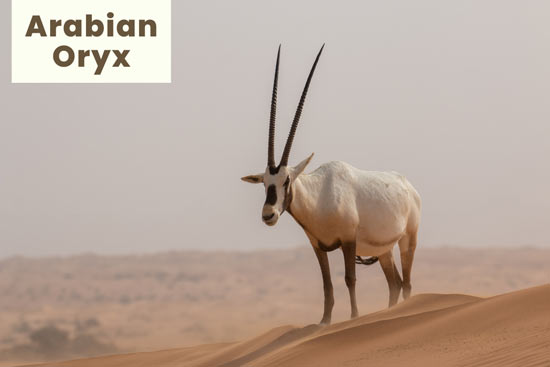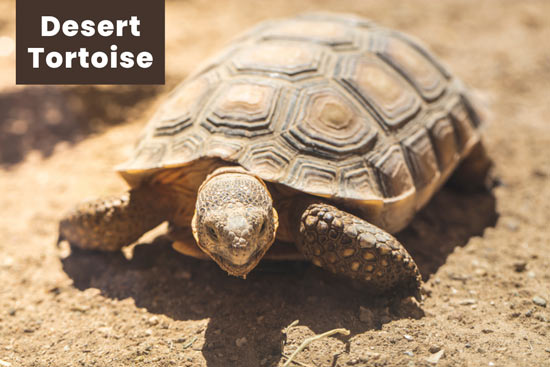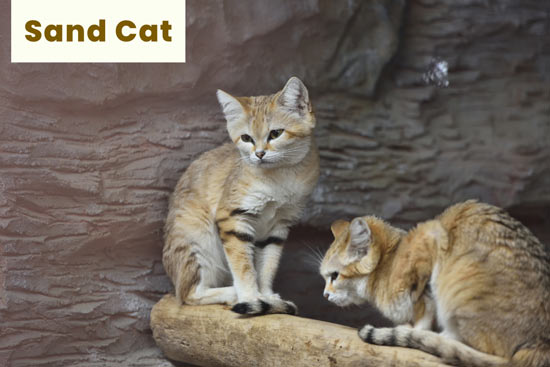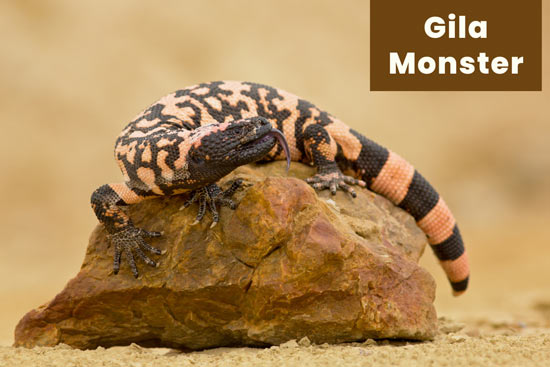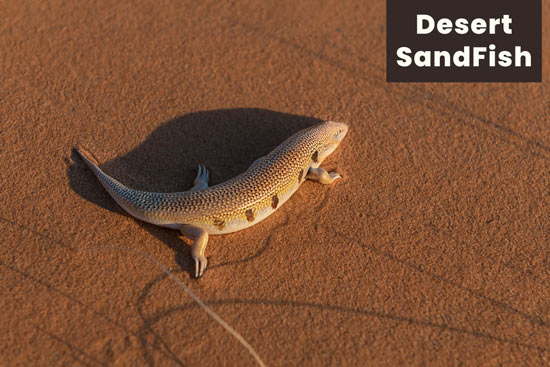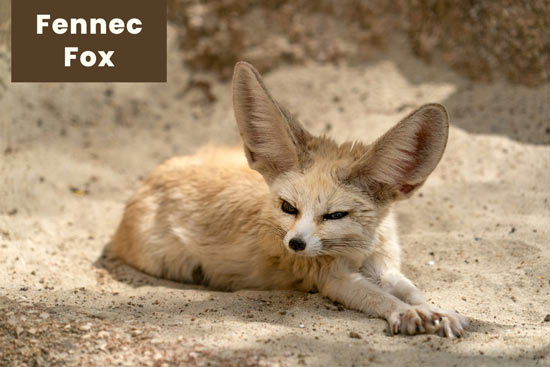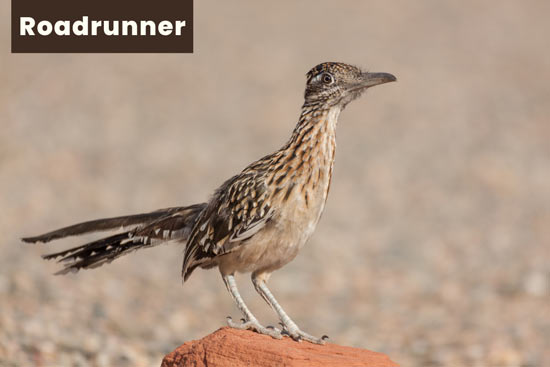There’s nothing like the scorching heat of a desert, or the vast expanse of sand and little vegetation. Then again, deserts are home to hundreds of species, including camels, scorpions, snakes, spiders, and many more. It’s amazing how desert ecosystem animals have adapted to extreme conditions. Here, we will learn about the major animals that live in the desert and call this arid region home! We’ll also learn how they cope with harsh climates.
Table of Contents
Deserts Introduction
A desert is a region that receives less rainfall. Most deserts receive less than 10 inches of rainfall every year. The desert can either be very hot or very cold. Usually, deserts are hot during the day, while the temperature falls drastically at night, around -3.9°C. Under this extreme climate, only a few animals and plants survive.
There are many different types of deserts globally, the Sahara Desert in Africa being the most popular one. Because of its vast expanse, which stretches over 9.4 million square kilometers, it is known as the world’s largest desert. Sahara is home to many animals, such as Fennec Fox, Dromedary Camel, the addax, and horned Saharan viper.
However, Sahara is not the only desert in the world. There are many others, including the Atacama Desert, Arabian Desert, Gobi Desert, Kalahari Desert, Great Basin, and so on.
Just like deserts around the world, there are different types of desert animals as well. For example, we find Arabian camels, oryxes, and wolves in the Arabian desert. While in the Gobi Desert, we find Bactrian Camels, snow leopards, Gobi bears, and so on.
Animals, plants, and organisms have evolved to survive the desert’s harsh climate and conditions, including barren lands and water scarcity. The arid conditions of the desert ecosystem mean that the soil, when disturbed, takes a long time to recover. In addition, the lack of water makes a desert vulnerable.
Animals That Live in The Desert
One-third of the earth is covered in deserts. Yet, despite such harsh conditions, the desert is home to many different plants and animals that have adapted in such a way that they can keep the temperature of the body optimum and can conserve water along with adapting to a nocturnal lifestyle.
Animals that live in the desert ecosystem include Desert Hedgehog, Meerkats, Arabian Oryx, Sand Fish, Camels, Jerboa, Gila Monster, Desert Tortoises, Desert Cat, Arizona Bark Scorpion, Camel Spiders, Inland Taipan, etc. Let’s look at them in detail:
Types Of Camels In The Desert
Camels are one of the most popular animals in the desert. Camel is called the ship of the desert. This is because humans hugely domesticate them for travel, textiles, and milk. As a result, they can survive without food and water in the desert for longer periods.
There are three species of camels found in the desert:
Dromedary Camel
Scientific name: Camelus dromedarius.
The dromedary, or the Arabian camel, is a species with a single hump and is the smallest of the three camel species. They are domesticated animals. Dromedary camel store fat in this hump that it uses as a source of energy when water and food are scarce.
Camels live in a group of twenty called the herd and feed on grass, grains, oats, thorns, wheat, and salty plants. A camel can survive without water for almost a week. The dromedary camel once lived in the desert of South Asia and the Arabian Peninsula; however, now they are found in Africa, Australia, and Asia.
Bactrian Camel
Scientific name: Camelus bactrianus.
The Bactrian camel is an existing species that lives in Central Asia. Derived from the name Bactria, a historic area in Central Asia. They are mostly domesticated.
The Bactrian Camel has two humps. These humps help store fat and are used in the form of energy when food and water are scarce. Its coat is woolly and is brown and sandy beige in color. Apart from the deserts, the Bactrian camel migrates to the Rocky Mountains, flat, stony plains, and dunes.
Wild Bactrian Camel
The wild Bactrian camel is an endangered species that reside in Central Asia steppes. These camels have double humps, which they use when water and food supply is low.
They are close relatives of the Bactrian camel, but since this species is endangered, they are restricted to wild and remote areas of the Gobi and Taklamakan deserts. The wild Bactrian camel is found in hills and dry plains. These wild camels are also faced with threats, mainly hunting. They are poached for meat and are seldom killed by wolves.
Types Of Scorpions in The Desert
Scorpion or “scorpionida” has a curved tail with a poisonous stinger at the rear end of the body. They also have pair of claws at the front. Scorpions in the deserts are usually light brown or yellow. They are mostly nocturnal, meaning they come out only at night and burrow during the day under rocks or in natural cracks.
Scorpions, among many other animals, adapt well to desert life. Following are the major types of scorpions in the desert:
Giant Hairy Scorpion
Desert hairy scorpions are the largest scorpions found in the Mojave and Sonoran Deserts of North America. They are also known as “Hadrurus arizonensis”. They live in crevices, burrows, grasslands, small caves, and wooded areas. Desert hairy scorpions are olive green in color and have small hairs along their tail. They are active in the summer and go dormant in the winter.
These solitary predators deliver a poisonous sting, although the venom of the hairy desert scorpion is weak compared to other scorpions. They can paralyze invertebrates and insects but don’t have strong effects on small mammals and lizards.
Deathstalker Scorpion
Deathstalker Scorpions are found in desert regions of the Middle East and North Africa. In addition, this species exists in the Arabian desert, Sahara Desert, and Thar desert. The deathstalker scorpions are yellow-brown in color. “Leiurus quinquestriatus” is the scientific name for this species.
This fearsome desert animal is considered the world’s deadliest scorpion. Its venom is potent, the most powerful among all scorpions. They are nocturnal and live-in crevices and hide under rocks.
Arizona Bark Scorpion
The bark scorpions are light brown and are commonly found in the Sonoran Desert. They take shelter during the day and come out to hunt at night for food. During winter, Arizona bark scorpion hibernates. Apart from crevices and rock, they are also found in trees and rock walls.
They are also known as “Centruroides sculpturatus”. This predator eats spiders, insects, and centipedes and even hunts other scorpions. Their life span is about 2–6 years long.
Types Of Spiders In The Desert
Although there are more than 45,000 species of spider worldwide, we will focus on those that live mostly in deserts. Let’s take a closer look at them.
Desert Tarantula
Scientific name: Aphonopelma chalcodes
Desert tarantulas are found in the southwestern United States. Although it has a very limited range, it is very common in Arizona and adjacent parts of the Mexico desert. They are also called Arizona/Mexican blond tarantulas. Tarantula eats insects, mice, toads, and frogs at night. These spiders have hairy bodies and are dark in color. Desert tarantulas can grow to about three or four inches long. Tarantulas are burrowers and live-in caves, cliffs, trees, and crops.
Camel Spiders
Scientific name: Solifugae.
Camel spider or wind scorpion is neither spider nor scorpion, although they have characteristics of both. They live in the scrub and semidesert region. They can inflict death upon rodents, birds, lizards, and insects.
Many myths surround camel spiders, including being dangerous, poisonous, fast, large, and aggressive, but they are just rumors and hold no truth. The camel spider is neither dangerous nor fast, and they do not contain any venom.
Wolf Spiders
Scientific Name: Lycosidae.
Wolf spiders live everywhere around the world. They reside in meadows and grasslands but also in deserts, mountains, and rainforests. Wolf spiders are solitary creatures and are nocturnal in nature. They eat other spiders and insects. They can do good camouflage and have great eyesight. But they are commonly attacked by birds, lizards, and rodents. When a wolf spider feels threatened, it will bite, but they are not harmful to humans.
Desert Recluse Spiders
Scientific Name: Loxosceles deserta.
Desert recluse spiders are native to the southwestern United States. They can also be found in Mexico’s northern region. A desert is a suitable place for these spiders to live because they like dry, sandy areas. These spiders can be dangerous to humans. You should see a doctor right away if you get bitten by a desert recluse.
Types Of Snakes In The Desert
Desert ecosystems are home to large numbers of snakes. As an example, we have covered three snake species here: Inland Taipan, Desert Horned Viper, and Sidewinder Rattlesnake.
Inland Taipan
One of the world’s most venomous snakes, the inland taipan lives in the semi-arid Australian desert. Generally, it is a shy and reclusive snake, and it is normally only seen when provoked or threatened.
It eats mostly small mammals, which it kills by injecting them with neurotoxins. The Inland Taipan strikes with lightning speed, injecting its victim with lots of venom. A single bite from this snake can kill 100 people, making it a terrifying predator.
Desert Horned Viper
The desert horned viper is a venomous snake that lives specifically in the deserts of North Africa but is also found in the Middle East, and parts of Asia. Its scientific name is “Cerastes cerastes”.
Desert horned vipers get their name from the distinctive horns on top of their heads. Their small horns may help them blend in with their surroundings, perhaps due to the variety of environments they live in. The venom of the desert horned viper is very potent, and it can cause serious illness or death.
Sidewinder Rattlesnake
Sidewinders are a species of rattlesnake. They are venomous snakes that are native to the desert areas of northwestern Mexico and the southwestern United States. It is scientifically known as “Crotalus cerastes”.
The sidewinder rattlesnake gets its name from the way it moves, which is sideways instead of straight like most other snakes. This form of locomotion helps them to avoid getting too hot and also allows them to move quickly and efficiently in the sand.
There are other snakes as well including Western Diamondback Rattlesnake, Arizona Coral Snake, Horned Adder, Mulga snake, etc.
Other Animals That Live In The Desert
The hot desert ecosystem is one of the harshest living conditions in the world. However, various land animals have evolved to survive in dry, arid climates.
The Desert ecosystem is home to reptiles such as king snakes, coral snakes, rattlesnakes, and lizards. Not only reptiles, but the desert ecosystem also accommodates birds such as roadrunners, vultures, and golden eagles and insects such as grasshoppers, beetles, bees, ants, and butterflies. A long list follows. We’ll look at more of them below:
Meerkat
Meerkats are inhabitants of the Kalahari Desert. Meerkats gorge on snakes, insects, and scorpions. To fulfill the water content, they also eat tubers and roots. They are burrowers and hide to escape harsh weather and predators.
Desert Hedgehog
They are commonly found in the Middle East and Africa. They have evolved to live in the desert and arid conditions and are very small in size. Desert hedgehogs are burrowers.
They hunt insects, eggs, scorpions, and snakes at night. They get all the fluids from their prey that help them to survive without water for long periods.
Jerboa
The jerboa is a lesser-known creature among different kinds of animals that live in the desert. This kangaroo-like animal is a rodent commonly found in the deserts of China, Mongolia, and North Africa.
They live from the hottest desert, i.e., Sahara, to the coldest desert, i.e., the Gobi Desert. By burrowing, they protect themselves from these extreme climates. Jerboas eat insects, vegetation, and dry seeds.
Arabian Oryx
Arabian Oryx is a large mammal with a white coat and is a herbivore.
The unique trait of this desert animal is its ability to sense rain over a long stretch distance which helps them find freshwater, plants, and grass. They eat during the night and take rest during the day. It gets its drinking water from the dews on the plant.
Desert Tortoise
Desert tortoise adapts to the extreme climate of deserts due to their large urinary bladder.
It stores water equal to forty percent of its body weight. This ability helps him go without water for more extended periods. Adult desert tortoises are known to survive without water for almost a year. However, they eat herbs, wildflowers, and fruits.
Desert Cat
The sand cat, also known as the desert cat, is a small but tough feline that is found throughout the world’s hot deserts. The scientific name of this species is Felis margarita.
They have perfectly adapted to life in the arid deserts of Morocco, Egypt, Algeria, Turkmenistan, and many more countries. During the day, sand cats rest in underground dens, and at night they hunt.
Gila Monster
The Gila monster is a solitary species with the scientific name “Heloderma suspectum”. This species lives in deserts and semi-arid regions where little vegetation flourishes.
It is a venomous lizard indigenous to the northwestern Mexican state of Sonora and the Southwestern United States. Also, Gila monsters tend to avoid flats and farmland areas, preferring rocky foothills. They are predators, preying on small mammals, birds, and other small lizards. Although Gila monster bites aren’t deadly to humans, they can be extremely painful.
SandFish
The sandfish, also known as a sandfish skink is a reptile (lizard) found in deserts. The scientific name of this species is “Scincus scincus”.
It is unique among reptiles in its ability to “swim” through sand, using the movements of its body to move forward. Also, its long, slender body helps it avoid predators. The sandfish is indigenous to the Middle East and North Africa, particularly the Sahara, Arabian, and Syrian deserts. Sandfish consume mealworms and crickets as part of their diet.
Fennec Fox
The Fennec fox is a small species of fox that lives in the deserts of North Africa all the way across Western Sahara and Morocco to the Sinai Peninsula.
It is scientifically known as “Vulpes zerda”. With its large ears, it can hear prey even when it’s burrowing underground. Those large ears also help the Fennec Fox keep cool in the desert by dissipating heat. Fennec foxes eat small rodents, lizards, grasshoppers, birds, and their eggs in the wild. To stay hydrated, they consume fruits, leaves, and even roots.
Roadrunner
The roadrunner is a desert bird that lives throughout the south-central and southwestern parts of the U.S. as well as Mexico. “Geococcyx” is the scientific name for this species.
Roadrunner’s name comes from its unique running ability, capable of reaching speeds up to 20 mph! That is equivalent to 32 km/h. But the Greater roadrunner can reach speeds of up to 42 km/h. It preys on crickets, caterpillars, reptiles, grasshoppers, beetles, and small mammals.
Conclusion
Desert animals have adapted to survive in one of Earth’s most extreme environments. This harsh climate is home to a wide variety of animals, from lizards to scorpions to snakes. There is no end to the list. Desert ecosystem animals play an important role in maintaining a balance between all the elements. When we know what animals need and how they adapt, we can more effectively protect this unique ecosystem.
